Civil War Battles
1861-1865
Seven Hundred Thousand Casualties
Contents
Chapter 1
1803-1860
Signals of Impending War
Triumvirate
Political Currents
Insurrection
Lincoln
1863 Battles
1864 Battles
1865 Battles
Civil War Facts
Consequences of the War
Death
Destruction
Union
Chapter 1
1803-1860
1861-1862
Signals of an Impending War
The south's agrarian economy was dependent on maintaining black Africans, or their descendants, in perpetual bondage to perform the hands on labor that was believed beneath the heritage of southern gentry.
By 1860, these social distinctions based on color created the economic system that became a cultural norm in southern states over 2 centuries.
In contrast, the northern states were creating, over a similar period, a commercial economy that featured industrialization, a shipping and banking industry that was more conducive to the employment of free men.
With less requirement for slaves, some in the north were more easily persuaded by the ethical component that held slavery to be immoral and against the will of the Lord.
The ink was hardly dry on Jefferson's Louisiana Purchase (1803) and on the Treaty of Ghent (1814) ending the war of 1812 , when Americans, hungry for land, were crossing agreed upon borders into Spanish, British and Indian territories.
As settlers streamed into the western frontiers, many were accompanied by their slaves as well as the mental baggage to extend slavery into the new territories.
By 1820, Congress entered the fray by passing a compromise measure. After a heated 10 day debate the agreement provided that Maine would be admitted to the Union as a free state and Missouri as a slave state. There was an amendment that forbade slaves above the southern border of Missouri except as to Missouri.
In 1854, the Kansas Nebraska Act nullified the Missouri Compromise that had limited slavery, and effectively gave settlers the right to determine the question of free or slave state for their territory.
Civil War Battles
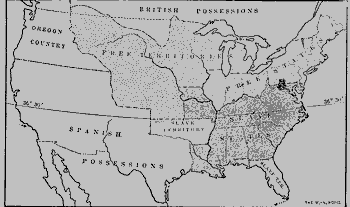
Civil War Battles
State of Missouri Joins the South - 1820
Thomas Jefferson, upon learning of the 1820 bill, presciently, declared in a letter that he had always believed the Union "would be of long duration. I now doubt it much".
Jefferson's opinion was reinforced by the debate over the United States annexation of Texas after that territory had declared its independence from Mexico in 1836. Its annexation as a slave state in 1845 only heightened the tensions between the northern abolitionists and the southern desire to maintain slavery. Texians (as they called themselves) viewed slaves as a requirement for bringing in large cotton harvests in the new state. Processing large crops were made possible by Eli Whitney's cotton gin invention in 1793. Europeans were desperate for cotton and they paid cash---a boon to a barter society in Texas.
Congress was unable to pass a consolidated package dealing with slavery. However, a compromise called for a vote on each bill, and was brokered by Senator Stephen A. Douglas of later Lincoln Douglas debate fame (1858). Thus congress was again active in 1850 passing single, piecemeal bills that declared California would enter the Union as a free state. Citizens of Utah and New Mexico would vote their conscience on the slavery question. Slave trade was abolished in the District of Columbia. To the bitter disappointment of abolitionists, federal officials were mandated to arrest run away slaves and ordered them returned to the owner. .
The congressional debate raged between the southerns led by John C.Calhoun and Henry Clay and from the north, Daniel Webster. His vote for the compromise ended his national elective career for higher office, but he did serve in the President Fillmore cabinet as Secretary of State, and fittingly in the the last Whig White House.
"Triumvirate"
Congressional Giants
|
Civil War Battles 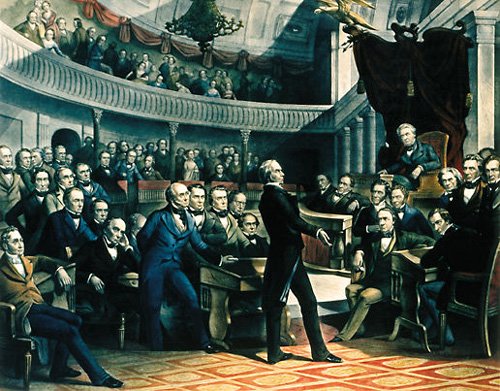 |
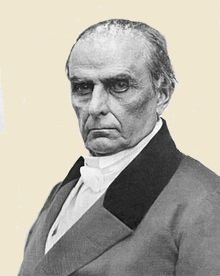 Daniel Webster |
|
Civil War Battles John C. Calhoun 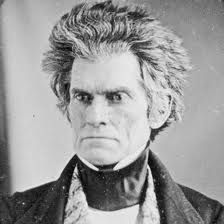 |
Henry Clay Civil War Battles 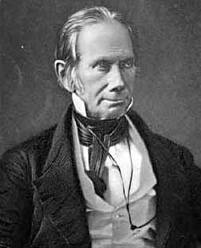 |
In 1857, the United States Supreme Court in the case of Dred Scott v. Sanford declared that a black person, free or slave could never attain citizenship, and had no standing to sue. Less known about the decision was that the law previously passed, the Missouri Compromise, that limited the right of a territory to permit slavery was unconstitutional. Slavery was again alive and well in the territories.
Congress and the Supreme Court again changed the map of the United States relative to slavery.
civil war battles
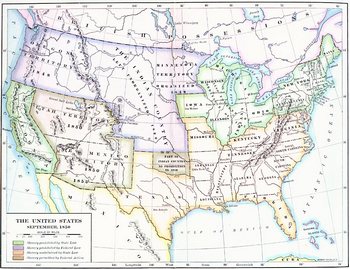
Slave states - - Texas to Virginia 1850
Political Currents
Popular opinion prior to the Civil War was reflected in its alignment with the growth of two major political parties, Democrats and Republicans. In turn, the policies of these parties crafted the national legislation that heightened the philosophical differences that resonated along regional lines. Some minor parties were predominately formed to promote single issues: Free Soil, as the name suggests , was adamantly against extension of slavery in the territories, and hence objected to the Compromise of 1850. In 1844, the Liberty party ran on an overtly anti slavery platform, an abolitionist candidate for president, and received barely 2% of the vote. The Quakers were one of the earliest movements for complete abolition of slavery. Only a civil war would settle that issue.
In the earliest days of the Republic (1780-1801), the political scene was dominated by the Federalists who ideologically favored a strong central government. As the new century progressed, the Whig party inherited the mantel of the Federalists that had collapsed as a national party by 1815.. They were opposed by Jefferson's Democratic - Republicans who believed in strong states rights to the detriment of the power of the federal government. "Republican" was dropped ten years before the mid 19th century and thereafter known as the Democratic Party. The Republican name was resurrected after the collapse of the Whigs in the 1850s over the slavery issue, and particularly votes on the Compromise of 1850 (above). Many of the abolitionist wing joined the new Republican Party.
Although the slavery question simmered in the early years of the Republic, regional life styles would dominate, and ultimately found a voice in the halls of government where "simmered" would reach the boiling point.
The Federalists/Whigs believed in government supporting the growth of industry and the growth of the commercial life of the north and, thus, less dependent on slave labor. The Democrats of the south were a reflection of an agrarian society with its highly conservative sentiments. That philosophy sought perpetuation of their traditional mores including the institution of slavery.
During the six years prior to the 1860 election of Abraham Lincoln, under the new Republican banner, this new party was ideologically opposed by the Democrats who were an amalgamation of the agrarian south and defecting southern Whigs. The southern element began to identify with the cultural beliefs of the states of their birth. The Whigs were totally fractured, and no longer viable by the mid 1850s. Their 30 year run was over. Some of its members migrated into the Republican ranks while the southern membership shifted allegiance to the Democrats.
By 1860, there clearly was a two party system. The bicameral congressional houses were split. The House was dominated by the Democrats of the south, and the Senate by the northern Republicans formed in 1854. Slavery dominated the conversation, but abolition was not part of the legislative agenda. Although the spread of slavery was the hot button ticket, the election of Abraham Lincoln was the proverbial straw that broke the back of the Union. One month later (December 20), the South Carolina General Assembly voted to secede from the Union and believed a state had that inherent right. Soon, thereafter, sister southern states assumed the same power.
In a study prepared by Fran O'Malley for the Delaware Social Studies Education Project, he classified the debate strategies that covered the issues that divided the extremists and moderates that could be found in each party:
A. Northern Extremists- are unconditionally opposed to the spread of slavery into the newly acquired territories. Some wanted to see slavery abolished altogether. Most northern extremists, however, supported the *Wilmot Proviso which would prohibit slavery in any territory acquired from Mexico. Article IV, Section 3 gives Congress authority over the territories.*
B. Southern Extremists- argue that slavery has to be permitted in all territories. You cite the 5th Amendment to the Constitution which protects a person’s personal property, including slaves. Furthermore, you argue that the 10th Amendment gives every state the right to decide the slavery question for itself. Therefore, slavery should be permitted in all US territories.
C. Northern Moderates- support the democratic idea that the question of slavery should be decided by the people living in the territories. According to the idea of “popular sovereignty” the people living in the territories should hold a vote to decide whether they wanted slavery or not.
D. Southern Moderates- argue that the solution which worked in 1820 (the Missouri Compromise) should be adopted in 1850. That is, the Missouri Compromise line (36, 30’) should be extended out to the Pacific Ocean. Territory which sits above the line should be free. Territory which sits below the line should be slave.
*( Wilmot proviso was never passed by the congress, but its sponsor, Congressman David Wilmot, was instrumental in forming the new Republican Party in 1854.)
The Democrats, at their nominating convention, split over the spread of slavery in their platform. It was a question of degree, but not one that anticipated the abolition of slavery. The result was the nomination of two candidates.
Even some Republicans were moderates on the question of slavery much to the chagrin of dedicated abolitionists. Candidate Lincoln was nominated by the Republicans on the third ballot. He believed that slavery was immoral, but that the Constitution supported that institution although "slavery" was merely implied by its language. Lincoln knew full well that the "framers" had not overlooked the word, but its insertion would have doomed the efforts of the Founding Fathers to establish a constitution.
Article I, Section. 2
Representatives and direct Taxes shall be apportioned among the several States which may be included within this Union, according to their respective Numbers, which shall be determined by adding to the whole Number of free Persons, including those bound to Service for a Term of Years, and excluding Indians not taxed, three fifths of all other Persons.
Article I, Section. 9, clause 1.
The Migration or Importation of such Persons as any of the States now existing shall think proper to admit, shall not be prohibited by the Congress prior to the Year one thousand eight hundred and eight, but a Tax or duty may be imposed on such Importation, not exceeding ten dollars for each Person.
Article IV, Section. 2.
No Person held to Service or Labour in one State, under the Laws thereof, escaping into another, shall, in Consequence of any Law or Regulation therein, be discharged from such Service or Labour, but shall be delivered up on Claim of the Party to whom such Service or Labour may be due.
Article V
...No Amendment which may be made prior to the Year One thousand eight hundred and eight shall in any Manner affect the first and fourth Clauses in the Ninth Section of the first Article.
Insurrection
In 1831, Nat Turner was preparing to fulfill the visions that he claimed had appeared to him for years. He was a slave and about to conspire with like minded brethren to destroy those who held black people in bondage. He later reported in his "diary" that " I should arise and prepare myself and slay my enemies with their own weapons."
He and several slaves entered white homes and shot and stabbed 55 persons to death. He was captured, brought to trial, adjudged guilty of murders and hung.
There had been similar conspiracy of slaves in the past, but were uncovered before brought to fruition. This Turner rampage caused Virginians to discuss the issue of slavery. Unfortunately, the issues had merely touched the edges of serious debate and relegated to a remote corner in the collective minds of southern society.
In 1859, John Brown, a white abolitionist, conspired to seize 100,000 weapons from a federal arsenal in Harper's Ferry, Virginia. (In 1863, the western region of Virginia became the State of West Virginia.) His intention was to commence a guerrilla war with the aid of slaves to rid the scourge of slavery. On October 16, 1859, his "army of liberation" controlled the armory and sought refuge in the fire house. In 36 hours, almost all of his force was dead at the hands of federal troops led by Lt. Col Robert E.Lee accompanied by Lt. J.E.B. Stuart. Brown's fate was a hangman's rope. The "fort" below as preserved.
Robert E.Lee would ultimately lead the Confederate armies and Stuart would again serve under Lee and add valuable services as a commander of the highly regarded rebel cavalry. Lee had a Revolutionary War blood line of that war's hero, "Light Horse Harry Lee".
Civil War Battles
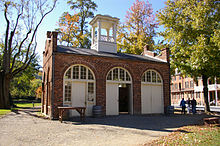
Civil War Battles
Lincoln
The emergence of the Republican Party with a core of defecting northern Whigs, formed in 1854, meant the appearance of fresh faces representing a strong anti slavery ideology. Although Abraham Lincoln lost an Illinois senatorial race to Stephen A. Douglas in 1858, he was gaining national recognition. He further burnished his views on slavery in a well published speech at the New York Cooper Union school in 1859.
Lincoln had the serious candidacy of William Seward to contend with at the Republican Convention in 1860. It took 3 ballots for Lincoln to gain the nomination. He faced 2 Democrat opponents in the general election and won without any southern Electoral College votes. He chose Maine Senator Hannibal Hamlin for his vice president.
His inauguration on March 4, 1861 was another in a long series of signals that the south interpreted as an attack on the institution of slavery. Apparently, it was a signal that South Carolina could no longer ignore and the response was an act of war starting at Fort Sumter. They had misinterpreted Lincoln's priorities and his resolves. Slavery, to Abraham Lincoln, was less a priority than a fight to save the Union.
"My paramount object in this struggle is to save the Union, and is not either to save or to destroy slavery. If I could save the Union without freeing any slave I would do it, and if I could save it by freeing all the slaves I would do it; and if I could save it by freeing some and leaving others alone I would also do that. What I do about slavery, and the colored race, I do because I believe it helps to save the Union; and what I forbear, I forbear because I do not believe it would help to save the Union. I shall do less whenever I shall believe what I am doing hurts the cause, and I shall do more whenever I shall believe doing more will help the cause." (Letter to Horace Greeley, August 22, 1862.Library of congress)
Civil War Battles
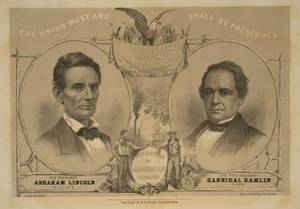
Civil War Battles
1861
Fort Sumter
South Carolina, and more particularly its premier city, Charleston, was the embodiment of southern culture. Its high standards of cordiality and beautiful architecture were hardly flash points for commencing a war. History reports otherwise.
The south had already asserted a state's right to nullify any act of the federal government it deemed unconstitutional, and the right of secession was then inherent in that precept. Thus on January 9, 19 days after voting for secession, student cadets at the Citadel Military Academy opened fire on a Union ship entering Charleston Harbor.
On April 12, General P.G.T. Beauregard began a 34 hour bombardment of the federal Fort Sumter ending in its surrender. Charleston would pay the price over the next 4 years.
President Lincoln immediately called for 75,000 volunteers. His intention was to pursue a narrow strategy that would attract broad support in the north and to do as little harm as possible to southern social institutions. The aim was solely the preservation of the Union.
|
Civil War Battles  Fort Sumter Charleston 1865 Civil War Battles Civil War Battles |
Civil War Battles 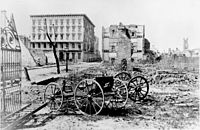 |
When Fort Sumter fell, their garrison was a significant part of the Union's regular army of 16,367 officers and men. The combined militias of the southern states exceeded that of the federal army. By the time that the war ended in 1865, the Union army would field 2.2 million men, and the Confederacy would raise about 900,000 men.
As early as April 1862, on the heels of the First Bull Run battle ( July 21,1861) President Jefferson Davis of the Confederate states instituted the first conscription in American history. Southern culture was displayed in the "deferment policy". Excluded from the draft were large land owners with 20 or more slaves and "hiring" substitutes was an approved policy. That policy was repeated a year later (March 3, 1863) in the Lincoln conscription bill that provided a substitution policy at a cost of $300.00 per man.
In July 1863, there were riots in New York
City objecting to the draft lottery. Mobs attacked the New York Tribune.
At the New York Times, the editor borrowed Gattling guns to hold the
mob at bay.
Although the war began in South Carolina, the early focus was Virginia. This state, unlike its southern neighbors, was not a cotton producer. Politically, it produced men who were quite attached to the philosophy of the union of states, north and south. The northern part of the state was populated with small farms mostly operated without slaves. Nevertheless, slavery was part and parcel of southern culture and deeply embedded in the overall economy. With some reluctance, they committed to secession. Their capital, Richmond, was chosen for that honor by the Confederacy, and was then marked as a prime target for the Union forces.
Many of the forthcoming battles were fought in regimental size which was divided into 10 companies of up to 100 men. In practice, the company, led by a captain, more than likely had no more than 60 men divided into two platoons, and subdivided into eight squads. The regiment was usually led by a colonel . Many of the colonels were appointed by their home state and had no army experience. There was the usual mixture of incompetence and extreme courage. Many of the inexperienced were remarkable tacticians and results proved this point.
Each regiment carried in its table of organization a surgeon with the rank of major and each company carried two musicians. Three to six regiments formed a brigade.and two to six brigades formed a division led by a Major General in the Union Army and a Lieutenant General in the Confederacy. Two to four divisions formed a corps. As a general rule, the Union army fielded smaller numbers in each of the sub divisions than the Confederate counterpart.
The months after the attack on Fort Sumter until July saw a number of skirmishes, few full scale battles, and none that significantly turned the tides of war.
.July 21: General Winfield Scott commanded the Union army, whose service also included the War of 1812. He also was the hero of the Mexican American War. Scott developed a two pronged strategy that included the coastal blockade of the southern states which the press dubbed as "Anaconda" (a strangling snake), and an 80,000 man force to take the Mississippi Valley (Roughly 80 regiments). That required time to develop. President Lincoln advocated a much more rapid strike that would end the war. He ordered an advance on Confederate forces entrenched about 25 miles south of Washington D.C. at Manassas Junction, Virginia.
The federal army was led by General Irvin McDowell who believed that his 30,000 men were insignificantly trained. The "rebels', 20,000 strong, were commanded by General P.G.T. Beauregard. They were dug in along Bull Run Creek a tributary of the Potomac River
Despite the raw recruits lack of training, their relentless attacks were on the verge of victory when southern reinforcements arrived led by General Thomas J. Jackson ("Stonewall"---standing "like a stone wall"). The Union Army was subjected to their counter attack which was accompanied with the blood curdling "rebel yell". Their ranks broke, and the attack became a rout. Their fear was magnified by the sight of a huge brass barreled lens that was rumored to be a new confederate rapid firing gun. In fact, it was the first appearance of the Mathew Bradley Manhattan photography equipment on the battlefield..
The Confederates had won the field, but had they thrown caution to the wind they could have marched into the Capital of the United States and easily captured it.
Casualties by the later standard of battles were remarkably light. Nevertheless, the images displayed horrified the north. This was a rude awakening that the war would not be a "cake walk" and threatened to be longer than public opinion anticipated. Civilians witnessed the battle like audiences in the Roman Colosseum. Unlike the Romans who anticipated the gore, Americans were shocked at the intensity of the battle and its mass casualties.
Each of the belligerents determined the name of the battle site. It became common practice for the north to refer to the locale by some natural feature of the land, e.g. name of river. the south chose to use the name of a nearby town. (The National Park Service often uses the southern methodology for the names of southern battlefields.)
The military professionals never anticipated the evolution that had occurred in a modern war. Weapons with rifled bores were more deadly and accurate. Defensive fortifications were more precisely engineered and new tactics had evolved to defend positions that were not easily overrun.
The balance of the summer of 1861 until early autumn was filled with numerous contacts between the belligerents, but carried no decisive weight in tipping the scale of war. However, the vituperative language between north and south was heated. The north began to refer to the war as the "war of rebellion", and the south adopted the "war of northern aggression". Foreign nations more aptly described the war as "war of secession". The term "Civil War" was a much later addition to the historical record.
Civil War Battles
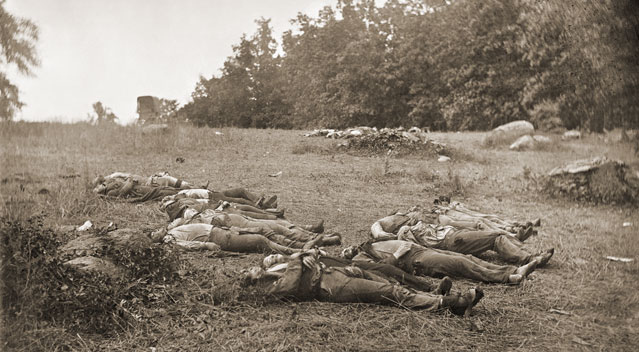
Civil War Battles
Eastern Theater
The general staffs of each army were now plotting geographical strategies and setting battle plans according to the four points of the compass. Armies were named according to their area of activity. Thus the Union referred to its northern armed forces as the Army of the Potomac. The Confederates countered with their Army of Northern Virginia. Each were now thinking in terms of "campaigns" with broad implications and targets rather than single battles.
October 21: The Union Army was looking for targets and prepared to attack the confederate encampment at Leesburg, Virginia. They ( led by Major General George B. McClellan) planned a diversionary tactic. The Union sent a force led by a former U.S. Senator, Colonel Edward D. Baker, to lead troops onto a bluff overlooking the Potomac River. More out of chance encountered in war, rather than by plan, the Confederates were moving in the same direction. There was an immediate clash of arms, and at least 1/2 of the Union force was killed including Colonel Baker. Post battle investigation revealed that the defeat may have been averted but for misunderstood orders issued by General McClellan. Ten days later (November 1), after McClellan's first Civil War defeat, Lincoln appointed him Commander of all Union forces replacing the elderly and infirm General Scott. McClellan had served under Scott in the Mexican American war.
This defeat, on the heels of Bull Run (90 days earlier), led to immediate congressional action. They ramped up their oversight powers and formed the Joint Committee on the Conduct of the War.
|
Civil War Battles 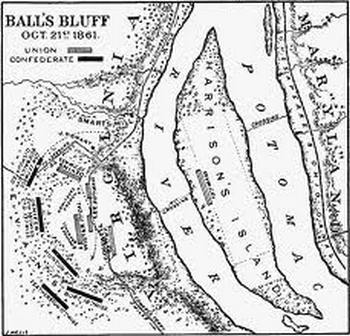 |
Civil War Battles 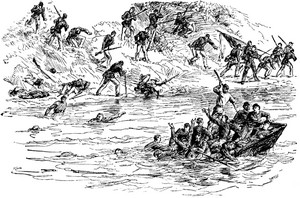 Escape into the Potomac River civil war diary wordpress.com |
1862
Despite Union losses, the Federal army controlled 50,000 square miles of confederate territory. They did not have the forces to protect themselves from the harassing Confederate cavalry. The railroad tracks they controlled were vulnerable to attack. Geography created the conflicting strategies between the early Union generals and those that succeeded them later in the war.
In the early years of the war, United States generals planned to seize Confederate territory, and gradually reduce the southerners grip on their states. This would force the enemy to ultimately understand the futility of continued resistance. President Jefferson Davis, president of the Confederacy, and also a product of West Point, famously said that the south would fight for very inch of its land.
Union generals, in the last years of the war, held a different view. Rather than fight and occupy enemy territory and wasting fighting men and material resources on routine occupation duties, their object was to pursue the enemy and annihilate their armies. The former view led to excessive caution and lost opportunities. The latter view piled up casualties and victories.
Both views began to clash when the old guard ran the show and the younger, more aggressive field grade generals were restrained. These strains became more evident at Shiloh. Major General Henry Halleck, although bore the same rank of Ulysses S. Grant, assumed overall command of the Grand Army of Tennessee because of his seniority. Halleck was cautious and fearful of defeat. Grant was aggressive, and when he was ultimately the Commander of all federal forces he operated his troops constantly in an attack mode, and a defeat was no deterrent.
Shiloh
Western Theater
Corinth
General Grant arrayed his 6 divisions west of the Tennessee River at Shiloh. With the river at his back, he was protected by a federal fleet of gunboats. His forces in February had taken the Tennessee Forts Donelson and Henry
This new Tennessee location, also known as Pittsburg Landing, was on the Mississippi border and in marching distance of the Mississippi town of Corinth, an important railroad junction and the ultimate Union target. His Army of Tennessee faced The Confederate Army of Mississippi under the command of General Albert Sidney Johnston. He was seconded by P.J.T. Beauregard, the same general who directed the bombardment of Fort Sumter one year earlier. Their orders were to halt the federal army and prevent their attack on Corinth, Mississippi.
Civil War Battles
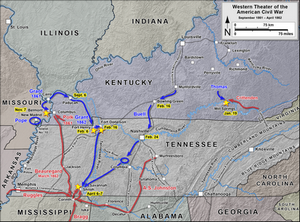
Drawn by Hal Jespers adobe illustrator CS5
Civil War Battles
April 6: General Johnston ordered a large scale attack across a broad front of the Union lines. The battle raged the entire day with the union forces being driven away from the protection of its river flotilla. Union lines were collapsing and a defensive stand was organized in a wooded area known as the "Hornets Nest" referencing the devastating confederate bombardment. This holding action, and the bravery of the "blue coats", provided Grant time to hastily reorganize his defenses with the onset of darkness. Although without the much delayed reinforcements promised by General Halleck, Grant could not survive the next day. The Union Army had taken a beating, and had the daylight lasted there would have been a complete collapse.The Union ships were filled with the dying.
General Johnston was not satisfied with the intelligence being relayed to him. He decided to reconnoiter close to Union lines. Defying the advice of his subordinates, he rode close to Union picket lines and was struck by a ball that penetrated his boot and lodged in his foot. He refused medical aid for the "minor" wound and bled to death. His loss must have struck a fatalistic chord with troops that held him in high esteem.
That night General Carlos Buell arrived with his regiments adding support to the Union lines. The following day, April 7,General Beauregard was forced to withdraw before the pressure of counter attacking Union forces and the cannonade from the river gun boats.
Casualties exceeded the combined losses of all prior American wars. History reports Shiloh as a Union victory albeit at great cost. Combined casualties: 23,000.
Civil War Battles
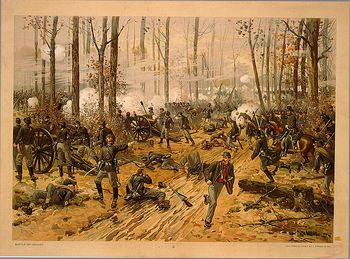
Thure de Thulstrip
library of congress
Civil War Battles
Corinth
General Halleck finally reached Pittsburg Landing with his fresh troops and set about the capture of Corinth across the Mississippi border. Cautious to a fault, fearful of ambush, his troops finally reached the outskirts of Corinth on April 29. He had marched his force 5 miles in 3 weeks. He immediately prepared for a siege of the town.
In the interim, General Beauregard had prepared dummy fortifications, and during the night had removed all of troops, sick and wounded, weapons and supplies utilizing the rail lines that Halleck had been ordered to capture..
The Battle of Corinth should more properly be named, "The Non Battle of Corinth". The actual battle was Shiloh. The combined 23,000 casualties elevates
the Battle of Shiloh not just as prelude to Corinth, but the actual battle itself.
Civil War Battles
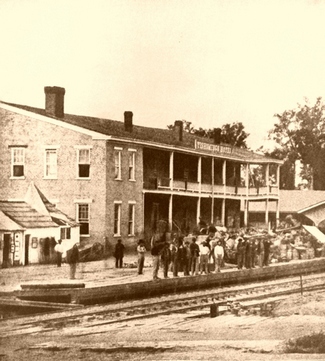
Railroad Target at Corinth Civil War Battles
www.legendsofamerica.com
Peninsula Campaign
Eastern Theater
Naval Activity
Virginia
General George B. McClellan had been appointed command of the Union armies (November 1, 1961). He then assumed the role of chief strategist. In a planning session with President Lincoln he proposed a campaign to capture Richmond, the confederate capital. Lincoln did not concur. He believed another thrust at the Manassas junction was the better course of action. Lincoln acquiesced to the military man. McClellan strategy was the agreed upon plan. It called for an amphibious landing on the southeastern peninsula of Virginia. It now meant that simultaneous campaigns were conducted in Eastern and Western theaters that required huge amounts of man power and resources.
McClellan was to lead The Army of the Potomac which he had formed and trained into a disciplined fighting force. He had also provided fortifications that protected the nation's capital. At Lincoln's insistence, he was forced to reduce his Potomac Army by one corps which was left behind to protect Washington D.C. McClellan later complained that this had substantially diminished his effectiveness on the Virginia peninsula which lies between the James and York Rivers.
The Army of the Potomac landed near Fort Monroe, Virginia in March of 1862 with 50,000 men and heavy artillery. His forces were destined to face the Army of Northern Virginia under the command of General Joseph Johnston, a duplicate of the cautious McClellan. Northern forces were quickly augmented by another 50,000. He had expected more reinforcements from Union operations in the Shenandoah Valley, but those troops were otherwise engaged in chasing the Confederates under Gen, T.J. Jackson. McClellan would also be confronted with rain every 2 out of 3 days causing severe illness in the ranks.
March 9: Before McClellan began his northerly march, the United States Navy had been sailing north on the James River intent on completing the encirclement of Yorktown. In the battle of Hampton Roads, the iron clad Monitor encountered the Confederate iron clad Virginia and fought to a drawer, but all but eliminated further naval participation (excepting some coastal bombardments) in McClellan's campaign. The prior day, CSS Virginia had demolished Union ships that sounded the death knell for wooden war ships.
The McClellan divisions began its slow trek up the peninsula toward Richmond. Their progress was halted by Confederate defenses at Lee's Mill along the Union's line of march aimed initially at nearby Yorktown. McClellan's over all command was now limited to his Potomac army as Lincoln, possibly frustrated with McClellan's dilatory tactics, removed him from supreme command of Union armies in early March. Northern public opinion at this time was becoming disaffected with the perceived delays that dogged McClellan strategies.
Civil War Battles
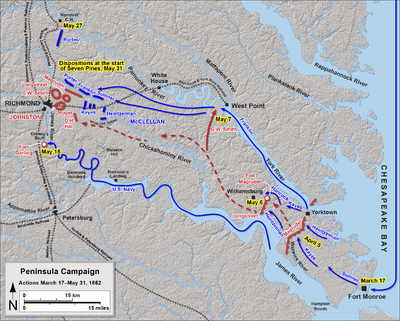
Drawn by Hal Jesperson
www.cwmaps.com
Civil War Battles
Lee's Mill
April 5: The unexpected obstacle at Lee's Mill was compounded by the clever strategy of the Confederate Maj. Gen. John Magruder who arrayed his forces to appear to be almost several times greater than his 11,000 men. Faulty intelligence, not improved by use of hot air balloons, failed to reveal the ploy.
Lee's Mill was essentially an artillery duel as the Confederates began an orderly withdrawal to set new lines of defense at Williamsburg. Fearing Magruder's supposed strength, McClellan had shown excessive caution in failing to order direct assaults against the enemy, and to take advantage of gaps in the Confederate defenses. By the end of May when Union troops were in six miles of Richmond, McClellan in his usual pause mode, was demanding 40,000 more men despite a manpower superiority over the Confederate army. Secretary of War Stanton reacted:
"If he had a million men, he would swear that the enemy had two million, and then he would sit down in the mud and yell for three".
The balance of April was devoted by McClellan to moving his large guns along the Yorktown road with occasional skirmishes that were Confederate holding actions. The most significant occurred at Dam No.1 with light casualties (April 16).
Civil War Battles
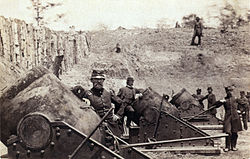
Library of Congress Civil War Battles
Williamsburg/Yorktown
Lincoln and Norfolk
.
May 5: Williamsburg was about 13 miles from Yorktown and the site of one of the earliest, large engagements pitting divisions against divisions, and confrontation between some of the more aggressive leaders on both sides of the lines. About 30,000 Confederates defenders matched against 40,000 "yankees". The day long battle featured artillery support for infantry attacks and counter attacks. At one point, Brig Gen Joseph Hooker's attack on "reb" lines was repulsed, then almost overrun by Maj. General James Longstreet's counter attack. Reinforcements aided Hooker and they were able to push the Confederates back to their defensive positions.
The day was concluded with a hand to hand assault initiated by Brig. Gen. Winfield Hancock's brigade against Maj. Gen. D.H. Hill grey, uniformed forces. The victory of the Union troops was sufficient to give McClellan bragging rights for the day's actions. However, it did give the Confederates what they needed the most---another day to delay and move resources for the defense of Richmond. Union casualties of approximately 2,000 exceeded that of the Confederates.
Civil War Battles
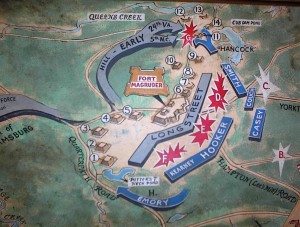
www.Williamsburgprivatetours.com
Civil War Battles
The balance of May was devoted to small skirmishes around the Yorktown area. One such encounter is noted not as to its size or effect on the over all war, but because of the presence of the President of the United States.
May 8: President Lincoln and two of his cabinet secretaries had landed at Fort Monroe two days earlier to get a first hand account of the progress of the McClellan campaign. He exercised his power as Commander-in-Chief of the armed forces to order his navy to bombard Norfolk and then take control of an empty city. Its immediate effect was to seize control of the James River and to prevent the CSS Virginia safe haven. As a result, the Confederates were forced to scuttle the craft.
Civil War Battles
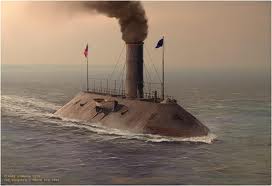 |
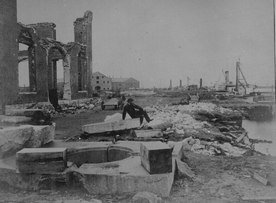 |
Civil War Battles
CSS Virginia computerized rendering Norfolk Docks Destroyed
Seven Pines
Winchester
May 25, 1862: Winchester was strategically located on an east/west roadway ending in Washington D.C. It was a hub for several railroads in and crossing the Shenandoah Valley that was designated by the Union Army brass as the Middle Department. The Union troops were racing to occupy this important center. General Thomas "Stonewall" Jackson swiftly moved his regiments, part of the the Northern Army of Virginia, to intercept the enemy. He routed the Union troops commanded by Nathaniel P. Banks, and captured a huge supply of war materiel much need by the Confederates. The Union forces barely escaped to refuge on the north side of the Potomac River thanks to the fatigue of the pursuing enemy forces.
This town would be revisited by enemy forces many times, and was again a battle ground in 1863 and 1864.
May 31: The Army of the Potomac encamped about 6 miles south east of Richmond in an area known to the Union as Fair Oaks and referred to by the South as Seven Pines. This was the site that Gen. Johnston chose to attack the Federal troops. The alternative would have involved subjecting Richmond to the heavy Union cannons, and a siege which his army could not survive.
The day continued with the heavy rains that plagued the armies for over two months. McClellan's army was divided by the swollen Chickahominy River. Johnson chose to confront the smaller force that gave his 50,000 man army an advantage over the Federal forces. The cast of leaders was essentially the same as at Williamsburg. The attack began 5 hours late because the Confederate Gen. Longstreet had taken the wrong road. About the time of the first attack, the Federal Balloon Corps was sent aloft and sent word to McClellan of the rebel movements.
Both armies were reinforced during the battle, and each side claimed victory. Casualties: 12,000 combined were evenly divided. General Johnston was severely wounded. President Jefferson Davis, a former West Pointer, added the duties of military commander of all his armies. entrusted Gen. Robert E. Lee with the defense of Richmond who promised that the city would not be taken.
For General McClellan who claimed victory, his letter to his home may have indicated his despondency:
"Victory has no charms for me when purchased at such cost".
|
Civil War Battles 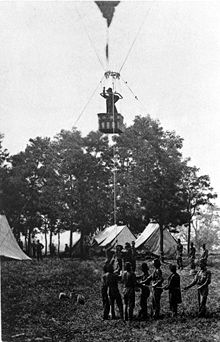 |
Civil War Battles 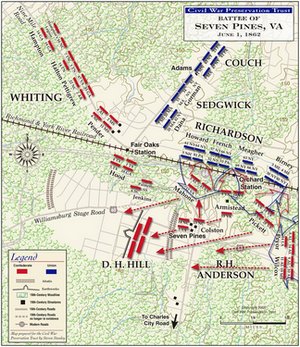 Photo: Mathew Brady Civil War Battles |
The Seven Days Battle(s)
The Union would remember Charleston, South Carolina and Fort Sumter through the entire war. On June 16 an attempt was made to capture this port. Federal forces attempted to gain control of Charleston Harbor by attacking James Island. Their failure had no effect on the war, but was a huge boost for southern morale. Several attempts were made against Charleston, but the south held it until February 1865.
June 26: This date began a week of battles that raged in Mechanicsville, Gaines' Mill, Savage's Station, Frayser's Farm, and ended in Malvern Hill on July 1. It also ended the Peninsula Campaign and McClellan's career. President Lincoln had sailed down to the James River to meet his general who claimed that he had not lost, but had failed to win. Clearly, McClellan had lost his nerve and some who served with him spoke openly of cowardliness. He suffered 10,000 casualties.
In reality, the Union Army had won 4 of 5 battles. The south lost 20,000 men. Their wounded were housed in every home in Richmond, but the city was safe. Lee had spent an entire week on the offensive and displayed that he was an audacious commander who would spare no one in the quest for victory.
Second Battle of Bull Run
August 28: General Lee was in character when he ordered his Northern Army of Virginia to attack the Army of the Potomac now under the command of General John Pope who had relieved General McClellan. The rail lines always appeared to be a magnet for the armies. Lee's army marched north and was led by Generals Longstreet and Jackson. Pope's command included General Irvin McDowell who had commanded Union forces at the first Battle of Bull Run one year earlier (October 21, 1961). The battle began with the cavalry raid on Pope's headquarters under the fiery Gen. J.E.B. Stuart. Then Jackson moved against a Union supply depot. The food and drink captured was a bonanza for Gen. Jackson's half starved men. One soldier reported on the bonanza:
"I soon found, in one corner of the second story, a room full of officers’ rations and several soldiers supplying themselves with coffee, sugar, molasses, etc. When we had appropriated all that we could carry, we found a barrel of whiskey, which we soon tapped; but as our canteens were full of molasses, and our tin cups full of sugar, we had nothing to drink out of. We soon found an old funnel, however, and while one would hold his hand over the bottom of it, another would draw it full. In this way it was passed around".
Civil War Battles
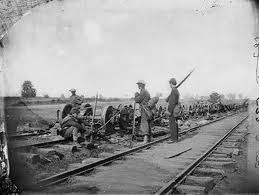
Civil War Battles
As the battle extended into a second day over the same territory as First Bull Run, it was evident that its scope would be greater than the earlier battle. Pope was now bent on catching Jackson's forces. General Pope has since been judged as always ready for the fight, but not a good tactician. He overlooked the substantial Longstreet reinforcements that reached Jackson.
On the third day, the Confederates had broken the Union lines over a 2 mile front. A repeat of a Bull Run route of 1861 was barely avoided by a strong rear guard action that held the pursuing Confederates. Total casualties: 25,000.
The final irony: Pope was relieved of his duty and replaced by General McClellan to lead the Army of the Potomac. Lincoln advised his cabinet pessimistically:
"We must use the tools we have".
George Templeton Strong, head of the Sanitary Commission, accurately observed:
"After all this waste of life and money and material, we are at best where we were a year ago".September 15: In this town, at the northern end of the Shenandoah Valley, was a cross road and entry point into the north and the south. It was a railroad junction, it had access to the Chesapeake and Ohio Canal, and its arms industry supported the Union Army. All significant factors to attract attention. There is one other fact that attracted Robert E. Lee. The town is a stones throw from the Maryland border. General Lee believed his success in Virginia would continue with a more northerly drive into Maryland.
Stonewall Jackson attacked the town and blessed his Confederate cause with immense war booty and 12,000 Union prisoners. It was his misfortune that he had to abandon Harpers Ferry to heed the call to reinforce the Northern Army of Virginia engaged in battle at Sharpsburg, Maryland.
Harpers Ferry would change hands 8 times (14 times including minor incursions) during the Civil War. and finally rest in the Union camp as part of the newly created state of West Virginia.
Civil War Battles
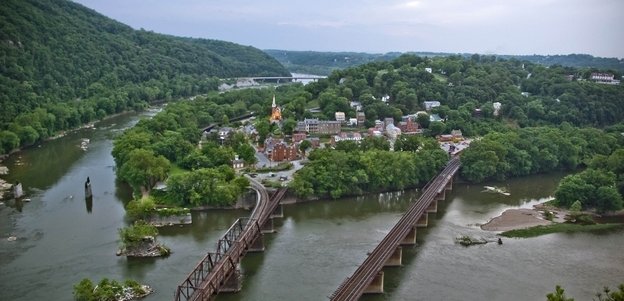
Civil War Battles
Antietam (Sharpsburg)
September 17: General Lee's Northern Army of Virginia crossed the Potomac after the battle at Bull Run. He was determined to give the Army of the Potomac no respite. Although his army had also suffered, he pointed his forces north into Maryland. Lee also believed that the presence of this troops would attract enlistments from Maryland and rebuild his depleted force.--an unfulfilled wish.
Opposing Lee, and again leading the Army of the Potomac, was a more confident George McClellan. In the days after Second Bull Run, his army had fought at Turner, Fox and Crampton Gap (September 14). They were battle hardened veterans. His subordinate, General Hoooker, mounted several early attacks which were thwarted as Lee, cleverly, moved troops from one flank to cover the point of attack.
The day began with an early morning attack on the Confederate left flank. The Union army began with a huge advantage in numbers,75, 000 men. Lee's forces began the day with one third of the Federal troop strength. Despite evidence and intelligence to the contrary, McClellan would insist the entire day that he was out numbered and therefore desisted from offensive actions, or pursuit, because of his imaginary fear of an imbalance. Some historians believe that Lee began the day with only about 20,000 men awaiting Jackson reinforcements from Harpers Ferry, which thanks to McClellan's 2 day delay to complete plans, arrived in time to augment Confederate lines leaving them with a definitive 2 to 1 man deficit.
Joseph Hooker began an attack on the Confederate left flank at the Dunker Church. Men , with fixed bayonets, charged across an open cornfield that was sprayed with shells and musket balls. The Confederates broke, but reorganized when reserves arrived under General John Bell Hood. The Union line broke and began to flee the field. Hood pursued and he was met by an artillery barrage and Federal reinforcements. It was now 10A.M. After 4 hours of battle 8,000 men lay dead and wounded. The Union advance had been halted. Hooker was wounded, but only one of 18 generals, evenly divided, to die or wounded by days end. Dunker Church, during the battle, housed Confederate armed with signal flags
Civil War Battles
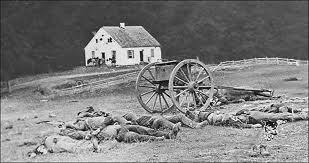
Civil War Battles Image@wpclipart.com
.
Now the battle shifted to the center of the Confederate line. Five separate attacks were mounted against the Confederates who lined a sunken country lane that divided separate farms. The road, now known as "Bloody Lane", were strewn with dead and wounded in grey uniforms. One more attack would have cut the center of Lee's army. McClellan did not believe that was "prudent".
Civil War Battles
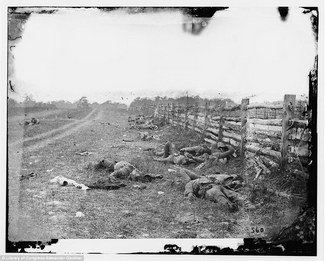
Civil War Battles
www.dailymail.co.uk
The last battle of the day was the Union attack on the enemy's left flank. They were led by General Ambrose Burnside's corps. A goodly portion of the fight was to gain control over a small bridge spanning Antietam Creek. (The Union army named battle sites after the nearest landmark, and the southerners would reference the nearest inhabited area.) Four attacks with 12,000 men were held back for three hours by 400 Georgians.They were suddenly reinforced by a Jackson Division under the command of Gen. A.P. Hill. Burnside called for reinforcements. Unfortunately, his plea was directed to McClellan and rejected. He and his troops were forced to retrace their steps over the bridge they had fought so hard to win.
The Confederates finally retired and joined a long line of retreating troops seeking safety on the south side of the Potomac. McClellan had his last chance to become an American idol. He failed to strike Lee's army which surely would have ended the war. Total casualties: 23,000.
For Lee, his invasion of the north was aborted. He had hoped that a victory would bring aid from England and France.Their neutrality was now assured. Lee would receive less encouraging news from his Western Theater of operations, and Lincoln did not extend third chances to McClellan. But it did give the Union bragging rights after the Confederates were first to leave the battlefield.
The victor's circle provided enough space for Lincoln
to announce the Emancipation Proclamation. The first draft was read to
his assembled cabinet on July 13 that freed slaves in those regions that were in rebellion. The Proclamation went well beyond the limited effect of abolishing slavery. It was critical in hastening the end of the war. The south was dependent on slave labor. Slaves planted and harvested crops and cotton. They contributed manual labor in southern seaports. Cotton was a cash crop that England paid for in the coin of the realm. Any diminution in the slave labor force would have long term military consequences.
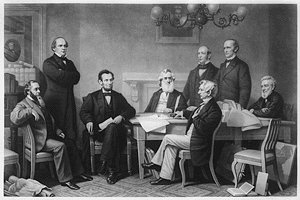
Congress followed on July 17 with passage of the Second Confiscation Act freeing slaves of everyone in rebellion. Lincoln completed a final draft of the Proclamation September 22. On January 1, 1863, Lincoln signed the final draft.
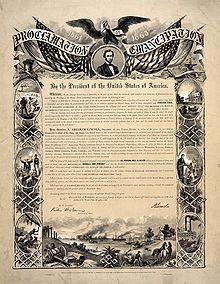 |
The operative paragraph:
Civil War Battle |
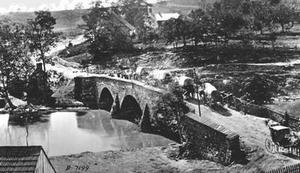
Antietam Creek Bridge Civil War Battles
online.wsj.com
Siege of Corinth
Western Theater
October 3-4: The Confederate Army of West Tennessee was led by Major Gen. Earl Van Dorn. It had recently been reinforced by troops that participated in an action at Luka in the prior month about 20 miles from Corinth, Mississippi. Corinth had been occupied by the Union forces in a bloodless battle in the past April. He was matched against Maj. Gen. William Rosecrans leading the Army of Mississippi (to be renamed the Army of Tennessee under the overall command of General Grant).
|
Civil War Battles 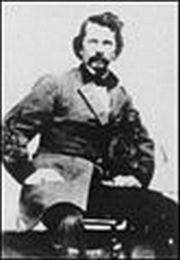 Van Dorn Civil War Battles Rosecrans |
Civil War Battles 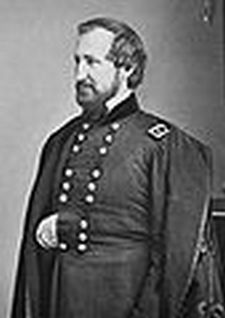 |
The Confederates were committed to retaking Corinth and its depot servicing the Memphis and Charleston railroad junction. The town, which was astride the Mississippi and Tennessee border was a gateway to central Tennessee and capturing it was an important Confederate strategy. There was parity of numbers between the armies----about 22,000 each.
Civil War Battles
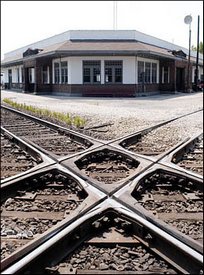
Civil War Battles
Van Dorn's forces advanced to 3 miles of Corinth and occupied rifle pits previously prepared by their brethern prior to their abandonment of the town the prior April. The field was littered with these holes and a harbinger of future trench warfare as the rebels filled the pits. Battle was joined at 9 A.M.
Rosecrans troops were shielded behind a perimeter of redoubts and pockets of batteries shelteriing large guns, each with identifying names. The grey uniforms relentlessly pushed forward ever closer to the town until darkness, heat and fatigue halted the attack.
On the second day, the fortunes of war shifted in favor of the Federals. Through a series of counter attacks, the Union was able to recapture Battery Powell. Across the line, Federal guns devastated the retreatin rebels. Van Dorn wisely withdrew from the field. A few rebels had reached the town, but were driven out.
General Rosecrans failed to pursue the retreating enemy---a tactic that appears ingrained in the old guard, officer class. The enemies would meet again..
Civil War Battles
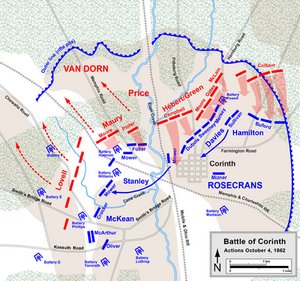
Hal Jesperson
Civil War Battles
www.posix.com/cwmaps/
Fredericksburg
Eastern Theater
General McClellan served at the pleasure of the Commander-in-Chief, President Abraham Lincoln. Upon receipt of the President's order, he turned over the command of the Army of the Republic to General Ambrose E. Burnside. Burnside's prior command had been in the last battle at Antietam in the past September. (See bridge above)
The Republican Party had suffered defeat in the mid term elections and were desperate for a victory. The New York Times believed that victory would be delivered by Burnside who had expressed doubts about his own abilities. The newspaper delivered this view:
“just the man, of all men now in the field, likely to illustrate by some daring act of war in which he has thrown all the energies of his chivalric soul.”
The Burnside command began November 7, 1962, with a resolve to confront the enemy. By November 15, he forced march his 120,000 men on a forty mile 2 day march into northern Virginia.
He stationed his divisions opposite Fredericksburg. Not coincidentally, the road led directly to Richmond, but several large rivers blocked the path. Bridges had been destroyed and an amphibious crossing was required. That delay was all the time necessary for the Northern Army of Virginia to reach Fredericksburg and establish a defensive line on the southern side of the Rappahannock River.
Crossing this wide river under fire presented a unique problem. Where to cross, when to cross, and how to cross. Burnside began preparing pontoon bridges and craft. He felt that crossing directly into town rather than on the Confederate flanks would be a surprise move. However, he was taking sniper fire from the town. His artillery then began an intensive shelling of Fredericksburg.
December 11-15: The Union troops began crossing in the mid afternoon and Federal troops were being hit and falling into the cold waters of the river. His forces faced a type of guerilla warfare, house to house, street to street. Then his forces faced the entrenched Confederate army and repeated frontal attacks were repulsed.
A Union advance on Marye's Heights was particularly bloody. In one hour, 3,000 blue coats were strewn across the field. Burnside acknowledged his inability to crack the Confederate line. His men recrossed the Rappahannock and the Eastern Theater was closed down for the winter leaving dead horses and destroyed caissons.
|
Civil War Battles 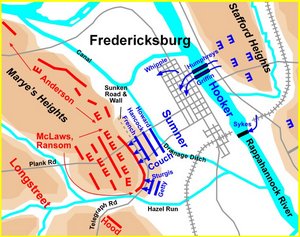 |
Civil War Battles 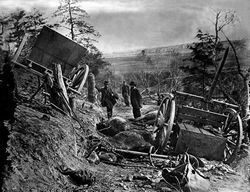 |
Continue to Years 1863-1865 (Chapter 2 of Civil War Battles)
American Wars | What Caused the Civil War | Civil War Battles